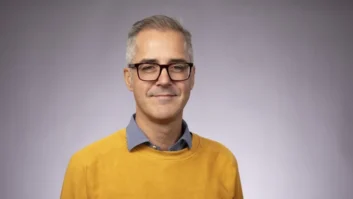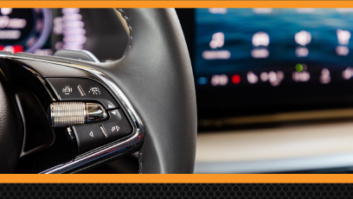Staying Connected with STLs
Nov 1, 2006 12:00 PM, By Doug Irwin

T1 interfaces have found common use in STL applications
The field of broadcast engineering keeps getting more complex. And though I sometimes pine for the days before computer automation, one thing I never miss is an old analog radio STL. While I still make use of one or two of the classic analog radios here and there, always in the back of my mind I remember that parts just aren’t available any more. I have to keep hoping that they never break. The little parts drawers are nearly empty. Fortunately most of them are back-ups anyway.
With the trend toward digital audio transport, and lately data transport, a whole new generation of radio STL systems has been developed. Their inherent advantages completely outweigh the problems that they happen to share with their ancestors. For example, with an older style analog radio, co-channel interference could easily be noticed (at best) as some low-level audio chatter and (at worst) not-so-low level audio and a beat note to go along with it. My experience is that digital radios can operate more easily in a co-channel fashion, as long the desired-to-undesired ratio is great enough for the local demodulator to ignore the �noise� signal from the undesired transmitter. (If you opt to rely on this, by the way, be certain that your desired signal doesn’t go through fades making it weaker, and that your undesired signal isn’t in a fade when you measure your desired to undesired ratio. Changes in the desired-to-undesired ratio while you aren’t looking may lead to great frustration later.)
The QAM modulation scheme of many of the digital radio systems seems to make them particularly susceptible to de-sense. Other transmitters keyed on and off (like paging transmitters) can make some of the digital demodulators lose lock, even with the receiver being far removed in frequency from the offending transmitter. That isn’t typically a problem with analog radios because they use FM (unless you are unlucky enough to have an intermod show up on your STL frequency). The solution in a case like this is generally a sharp-skirted filter to keep other RF out of the front-end of your receiver. Getting a better antenna and using horizontal polarity (if possible) are other ways to reject signals from many other communications systems transmitting from mountaintops.
The current generation of digital radio STLs sound great, but like many other systems in radio, they aren’t necessarily plug and play.
The primary advantage of any digital system vs. an analog system that operates within a limited dynamic range is the consistent quality of the sound. The dynamic range of audio encoded in a digital system is essentially fixed and is defined by the word length.
The dynamic range of an old analog system is defined by two things: the noise floor (in the case of an analog radio system or analog tape) and the limit of headroom (100 percent modulation in the case of an analog radio, the saturation point of tape).
Staying wired
Wireline STL systems have come a long way in the last 20 years. I never had the opportunity to use copper loops for an STL � although it was common everywhere in the old days. (You were indeed lucky if your studio and transmitter site shared the same central office) Getting a 15kHz pair was, in many instances, a crap shoot; the performance depended on the skill of the telco techs that aligned the system. If you sent audio between central offices, then the audio had to be converted to digital (and truncated to 11 bits), sent over a T1, and then reconverted back to analog on the far end. If you could get 65dB of dynamic range you considered yourself lucky.
Trying to explain the frequency response vs. headroom trade-off to some telco techs was indeed something that could try your patience � and it used to be that if we got a good field tech, then we knew the lines would work. We always tried to get the same tech for the next time. (Now they’re all retired.) Once again, advances in other communications technologies (like the cellular telephone) have had a positive benefit for broadcasters: with more users at typical transmitter sites, many telcos installed fiber, dramatically increasing the reliability of wireline STL systems.

The copper loop has entered the digital age with the Pulsecom PCAU and HD PCAU.
Perhaps more significant though was when we were allowed to generate the data ourselves for subsequent transport over telco T1s. After that happened, the floodgates opened. Intraplex began selling its channel banks directly to end users. It included the A/D, and at the far end, the D/A, that gve broadcasters more control over the sound of the radio station and many other handy features. Other manufacturers jumped at the same chance not long after.
We have actually come full circle with wireless connections now that Pulsecom and APT have partnered on the PCAU and HD PCAU. Both work with dedicated lines to provide digital links via copper.
The nature of data transport via digital data circuits (such as a T1) is that it is bi-directional � in fact full-duplex � and so signals can easily be brought back in the TSL direction. A common example would be the backhauling of air monitor or audio from an RPU receiver. Those are not functions that you are typically going to carry out with a radio system.
The ability to extend the station’s LAN to a transmitter site has nearly become a necessity in the last couple of years. First, it was only because it was handy to have a computer at the transmitter site to retrieve e-mail or look at manuals online. Now there are many other reasons for it, not the least of which is HD Radio (although you only need the data going in one direction for that). Radio systems that can do that also are fairly easy to come by, but nearly all of them work in unlicensed ISM bands and as such, use low power, limiting their operational distance, and are ultimately subject to interference from other unlicensed users. That being said, I recently installed a 5.8GHz ISM band radio making use of a four-foot dish pointing right at downtown Seattle. Using a spectrum analyzer, I saw absolutely nothing else but the transmitter on the other end of the link.
Any digital STL acquired in this day and age should have the following capability, at minimum: the ability to send one AES data stream, embedded with left and right channels, sampled at 32kHz (44.1kHz if you want to be able to generate the HD MPS at the transmitter site) with 16-bit resolution; and full-duplex data connectivity for TCP/IP applications. Alternatively, if you intend to make use of the exgine architecture for an HD Radio application (and you don’t need a LAN extension) then a simplex data connection will be adequate. The recommended minimum data rate is 300kb/s.
Staying Connected with STLs
Nov 1, 2006 12:00 PM, By Doug Irwin
Current offerings
Moseley Associates has offered the SL9003Q Starlink for many years. A recently introduced configuration is the SL-9003Q-2SLAN that provides one AES data stream (44.1kHz sample rate stereo pair) with simplex data at 544kb/s rate. If the user wanted to build a full-duplex data system, he could opt to install a Moseley Lanlink as well, which (by way of duplexers, using the same path with the same antennas) inserts a data transceiver on both ends of the system, with Ethernet in and out. The Lanlink operates in the 900MHz ISM band, and it is an independent system that could be used with any 950MHz band STL. By the way, you could use it right along with your old analog STL.
And perhaps you have no need for high-speed data to your transmitter site; you just want a digital STL to take advantage of the sound quality. There are plenty of radios out there that will do just that. TFT offers Model 460, which can carry three AES data streams (stereo embedded, 32kHz sample rate, using 256 QAM) in an occupied bandwidth of less than 500kHz. Again, an advantage of a digital scheme: This radio is specified to have a 10E-6 BER for a -84dBm signal level. Obviously you can’t do that with an analog radio.
Harris’ digital radio STL is the CD link, which will transport one 16-bit AES data stream and two RS-232 data channels. An option is to replace the RS-232 data with two 6kHz audio channels or a single 12kHz audio channel.
Armstrong recently introduced the Xlink. This is a microprocessor-controlled analog radio with the standard features � three SCA inputs, one composite and one mono input. It is frequency agile, making it handy as a spare for a station group. Armstrong can provide a two- or four-channel digital encoder/decoder pair that can be loaded in the Xlink, making a cost-effective upgrade to digital.
Broadcast Electronics offers the Big Pipe system � a mainframe chassis that uses plug-in interface modules for specific functions, such as audio transport or Ethernet. The link ends communicate via unlicensed channels in the 5.3GHz ISM band. BE has also recently introduced Big Pipe LT, which is a single-rack unit version that allows for Ethernet connectivity up to a 45Mb/s data rate.
My policy for many years has been to operate radio STLs as back-ups, making use of the reliability and flexibility of digital (wired) STLs for my mains. If you were to implement the same policy you’d have many choices from which to pick for equipment.
Harris/Intraplex is kind of the granddaddy in wireline STL equipment. The STL HD is a package of two 4RU frames that contain modules that transport the AES data stream (later transmitted over the analog transmitter) along with another set of modules that transport Ethernet. (This set would be used to carry the UDP data packet stream that carries the MPS and SPS should you opt to use the exgine architecture for HD Radio implementation).
APT offers the Worldnet Oslo, a 3RU frame system that uses plug-in modules to transport as many as 14 stereo audio pairs. Options for the audio transport are non-compressed, linear; 48kHz sampling, 24-bit resolution Apt-x or Enhanced Apt-x. The system can operate over T1, E1 or IP networks. APT has also partnered with Pulsecom to distribute the PCAU and HD PCAU for wired digital loops.
Musicam USA has a product known as Team, which is a mainframe-based system that makes use of plug-in modules that carry out specific functions such as audio transport. The Superlink is another mainframe system made by Musicam. It too uses plug-in modules for specific functions like audio transport; in addition it can bond multiple ISDN circuits � as many as three � for a total of 384kb/s data throughput. Aside from ISDN, the Superlink can also communicate via Ethernet, ATM or T1.
Options abound for digital transport to your transmitter site. As the means by which entertainment content streams are distributed increases in number, it’s wise to build an STL system that has not only great initial capability but also scalability as well. TCP/IP capability for your transmitter site is now nearly a must-have, and generally speaking, digital transport of program audio is just easier than the old analog methods and it sounds better anyway.
Irwin is a broadcast engineer in Seattle.
Manufacturers of STL equipment and accessories
Airlink Communications
510-781-9700
www.airlink.com
Armstrong Transmitter
315-673-1269
www.armstrongtx.com
APT
800-955-APTX
www.aptx.com
Bext
619-239-8462
www.bext.com
Bitrage
904-808-0656
www.bitrage.com
Broadcast Electronics
217-224-9600
www.bdcast.com
DB Elettronica Telecomunicazioni
+39-49-8700588
www.dbbroadcast.com
Digital Juke Box
740-282-SOFT
www.digitaljukebox.com
DMT
856-423-0010
www.dmtonline.us
Energy-Onix
888-324-6649
www.energy-onix.com
Harris
800-622-0022
www.broadcast.harris.com
Kathrein, Scala Division
541-779-6500
www.kathrein-scala.com
Lightpointe
866-376-5878
www.lightpointe.com
Marti Electronics
217-224-9600
www.martielectronics.com
Mayah Communications
+49 811 55 16 0
www.mayah.com
Microwave Filter
800-448-1666
www.microwavefilter.com
Microwave Radio Communications
800-490-5700
www.micbroadcast.com
Moseley Associates
805-968-9621
www.moseleysb.com
Musicam
732-739-5600
www.musicamusa.com
Nicom
619-477-6298
www.nicomusa.com
Nucomm Microwave
800-9-NUCOMM
www.nucomm.com
OMB America
800-662-4872
www.omb.com
Pulsecom
800-381-1997
www.pulse.com
QEI
800-334-9154
www.qei-broadcast.com
RF Technology
800-762-4369
www.rftechnology.com
Samco Antennas
817-336-4351
www.samcoantennas.com
SBS
+44 1789 768870
www.sbsfm.com
Superior Broadcast Products
800-279-3326
www.superiorbroadcast.com
Telewave
800-331-3396
www.telewave.com
TFT
800-347-3383
www.tftinc.com
Trango Systems
888-400-8886
www.trangosys.com











